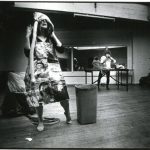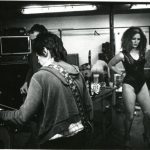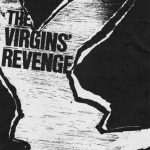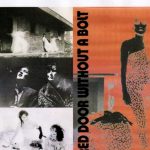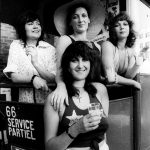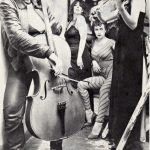Company name: Sadista Sisters
Founders: Jude Alderson and Teresa D’Abreu
Established: 1974
Reason: The developing fringe theatre at the time had little to offer women in terms of roles, or even as audience members; the company was formed as ‘a direct response to the male-dominated establishment theatre of the early 1970s.’ (Sadista Sisters Blog)
Current Status: Disbanded 1987. No specific reason other than a natural dissolving of the company due to members’ other commitments. Crucially the company’s dependency on Jude Alderson to function meant that once Alderson decided to invest more time in other projects, Sadista Sisters was no longer producing work. Jude Alderson went on to found Amazonia in 2011, which is currently active, and which she considers very much an extension of Sadista Sisters’ work.
Area of Work: Women’s
Policy: ‘This company aimed to explode myths about the female psyche and challenged the notion that women are there to serve as ciphers for male protagonists in theatre. This music/theatre company – eclectic, savage, funny, tender and populist exploited everything from performance art to punk – and carried on in many incarnations for 14 years. It was a marriage of many styles’ (Sadista Sisters Blog). Members came from politicised backgrounds, mainly socialist. The work intended to be rebellious, to challenge stereotypical images of women and particularly women’s sexuality.
Structure: Informal collective, but Alderson always leading at first. Recruited musicians on a casual basis and didn’t have set rehearsal times or spaces for many of their shows. Alderson was always somewhat at the head although there was no official hierarchy. Sometimes an external director would be hired, for example Bob Mason for Duchess and David Sibley for Red Door Without A Bolt. State funding meant greater organisation had to be implemented and this was not always associated with a decrease in stress and difficulties for Alderson, who was running the company almost single-handedly; although it did enable some ambitious projects, especially in terms of design. From Duchess onwards, the plays and music were written by Alderson.
Based: London, although were successful abroad, especially Germany, and spent a significant amount of time there.
Funding: Received Arts Council funding for Duchess and Red Door Without a Bolt
Performance Venues: Mixed venues: theatres, pubs, school halls, music festivals, theatre festivals. They played a season at Ronnie Scott’s Jazz Club in Soho, and toured the UK, Germany and Holland extensively. Venues included the Treibhaus in Berlin, which had been on the brink of closing but Sadista Sisters sold out for 3 weeks and ‘turned it around’. They also played to 100,00 people in Vondel Park in Holland and 4,000 people in the Fabrik in Hamburg.
Audiences: Mixed – both men and women, although in certain venues and for certain shows there seemed to be a specifically female cult following.
See Jude Alderson’s web page for more Sadista Sisters images
Company work and process: Jude Alderson and Teresa D’Abreu had worked with Steven Berkoff and whilst they had enjoyed the energy and passion of the work, they were disappointed by the female roles. They were not experienced writers but they decided to start making their own work.
Alderson’s writing was compared to Brecht’s because of the juxtaposition of images in her work; the political and the personal, glamour and domesticity. There was a strong concern with the contrast created when domestic paraphernalia, for example, was placed on stage alongside glamorous outfits, or when a gynecological clinic was instead equipped with ‘manlier’ tools such as hammers, spanners and saws. The first ‘show’ resembled more the style of a happening, rather than a play or a cabaret show; it featured Alderson and D’Abreu emerging from two large female legs dressed in baby-like masks and pink catsuits, singing Baby Doll (1973)
The company quickly grew to 9 members, first acquiring Jackie Tayler, who was writing music at the time, and Linda Marlowe, who had also worked with Berkoff. Other members were recruited through an informal process of meeting different artists and musicians with similar ideas. The company was immediately noticed for their wild streak and the quality of their songs and were signed by Transatlantic Records in 1975; however this oppositional element characteristic of the all-female, mostly working class ensemble was ultimately stifled and toned down by the record company who chose to replace the female musicians with male session players. This was the company’s first conflict with the music industry and a moment of realisation that they had made a terrible compromise.
Sadista Sisters began to tour in Germany, where the political cabaret style of music and theatre was more easily identified. This Brechtian but populist style of work resonated with young left-wing German audiences. Even in Germany, however, the audience response was not always accepting of the women’s outfits, make up and content of the shows.
There was no strict or recurring creative process involved in the production of their work; the work of the company is described by several members as chaotic and somewhat defined by this. Initially, when the company consisted of D’Abreu and Alderson, the two would retire to a room above a pub with a piano and work with music, writing and theatrical vision simultaneously. Rehearsals were not formally structured, and nor were specific roles during the devising and writing process.
Initial ideas, scripts and visual concepts mostly came from Alderson, and then the shows were created as an ensemble, with other members (mainly Jackie Tayler) composing the music. Although some of the shows had distinct cabaret qualities, and were structured as a series of sketches, there was always a narrative to follow. There was, particularly in Britain, a discrepancy between the style of the shows – the loud rock music, the eccentric costumes, and the rebellious streak of the actors and musicians – and the venues they played in. Traditional theatres did not seem to complement the pushing of boundaries that Sadista Sisters were known for, and clubs did not accommodate the chaos characteristic of the shows.
The work of Sadista Sisters explored issues such as sexuality, prostitution and the reality of doing the job of a prostitute, madness, women and work, race, and motherhood. In Red Door Without a Bolt (1981) the main character Winnie descends into madness after a failed marriage. Another very talked-of show was Madonna in Slag City (1986), a tribute to the women of Greenham Common featuring 17 women, directed and with music by Alderson, which ran at the Oval House for three weeks. Madonna in Slag City dealt with war and radicalism, and during rehearsals the women were trained by a war veteran.
Images and sounds dominated in Sadista Sisters’ work both as inspiration to create shows and during the shows themselves, and these elements were considered more important than clear political messages. Their work was a rejection of didacticism in theatre, wanting instead to ‘poke’ the imagination of the audience. This kind of theatre is about imagery and emotion sometimes before it is about words.
Personal Appraisal and Thoughts:
Jude Alderson (2007): ‘Seems naive now…although in its time it had a real anarchic streak and I think it did serve as some sort of role model particularly for working class women [because it featured] a lot of humour, satire and social issues and a combination of music and politics, and I think all those things worked pretty well. I think looking back, that the company had a real originality and I see a lot of the images that we were creating, now. I think that if we were around now we would be very successful, but of course it was also chaotic and I’m sure at times the work was total crap as well.’
In terms of negative criticism aimed at the company for being too close to the edge and pushing the boundaries of what was acceptable to present on stage: ‘It’s hard to completely know if you are putting an image of the sexually alive woman … it’s hard to know what you create.’
Sadista Sisters Blog: [On the Transatlantic Records contract, 1975] ‘In retrospect, bringing men into the band was a kind of disaster, because there was a sense of alienation and some personally very damaging stuff. I certainly felt put down by it although I couldn’t really express it at the time.’
Jean Hart: ‘Why it was successful I think was because it shook the audiences up who were used to looking at the fight for equal wages, sexual politics … the right for birth control, all those kinds of things, looking at something much more important, women’s feelings and sexuality alongside the traditional stuff. That actually made it incredibly successful, and a joy to do.’
Reviews:
Madonna in Slag City
‘The old Sadista weakness… the tendency to merely reflect sexism, especially fear/loathing of the female body, instead of exposing and then deflecting it.’ (Spare Rib, 1986)
‘Politically, it is a minefield, unashamedly mystical about ‘women’s power,’ caricaturing masculinity (but still giving those caricatures a lot of stage time).’ (Spare Rib, 1986)
A Cabaret of Political and Sexual Blasphemy
‘For years the Sadista Sisters have played the jazz and club circuit disturbing and titillating audiences with their bizarre brand of cabaret. Brilliant performers who don’t ooze over the stage the way nice girls should but haughtily hint at hot sex and passion – with castration as the man’s reward at the end. Their image has been of female refugees from the upper middle class who’ll lay then slay you. … In their new show there’s less of the funky female eccentric and more of the upfront feminist. …as with all their work, it is exquisitely performed and very funny. … It is in their music, the area that they have traditionally concentrated on, that the Sadistas are at their best. … The beautiful Sister Amazonia for me suggests a woman trying lesbianism, then going back to men – ‘What happened to your sweet ambition/don’t tell me that you’ve lost your nerve/and indulged in something wrong/…Sister Amazonia/you dare to change your mind/a female euphoria is very hard to find’ – as well as a woman reluctantly having an abortion – ‘Your womb was full of wisdom/but your orders were to kill’… Many companies on the Fringe started out with the conscious aim of making political statements, then developed their theatre skills from there. It is heartening to find that, in what is already an established group, the process can be the reverse.’ (Spare Rib, 1979)
‘Their act contains all the elements of successful cabaret – a polished and versatile band, powerful songs, three exceptionally accomplished and beautiful front-line performers, and an act that is shocking, topical, challenging and hilariously funny. The audience in this cabaret never has a chance to relax, but is led by the performers through a gothic show that upturns expectations yet is also remarkably loving, that walks a tight-rope between the mush of titillation and the mire of the grotesque, so disturbing to an audience that it is no longer funny.’ (The Guardian, January 19th 1979)
Productions:
| PRODUCTIONS | VENUES | DATES |
|---|---|---|
| First show/happening Cast: Jude Alderson, Teresa D'Abreu | Hardrock Café | 1973 |
| The Sadista Sisters Cast: Jude Alderson, Teresa D'Abreu | The King's Head | 1974 |
| Cinderella | Quartier Latin, Berlin Stuttgart (during German and Dutch tour) | 1976 |
| Out to Lunch | King's Head | 1976 |
| A Cabaret of Political and Sexual Blasphemy Cast & musicians: Jude Alderson, Jean Hart, Jackie Tayler, Kate Phelps, Pauline Melville | Roundhouse Oval House Various Venues in Stockholm Club 7, Norway | 1977 |
| Duchess | Project Theatre, Dublin Liverpool Everyman Milton Keynes | 1979 |
| Red Door Without a Bolt | Old Half Moon Glasgow Third Eye Edinburgh Festival Tricycle Leicester Brussels Holland | 1981-83 |
| Easy Prey with Cunning Stunts | King's Head | |
| Madonna in Slag City Writer: Jude Alderson | Oval House London University (Later performed at Jack Lyons Theatre, Royal Academy of Music, with different cast) | 1986 |
| The Virgin's Revenge Writer: Jude Alderson Cast: Claire Benedict, Karen Parker | Oval House (A film was also made) | 1987 |
| Sadistas Revisited | Drill Hall | 2010 |
Interviewee reference: Jude Alderson, Jean Hart
Links: Sadista Sisters Blog.
Amazonia Music Theatre
Listen to The Sadista Sisters album made with Transatlantic Records here .
Existing archive material: Reviews, photos, posters and other material in Jude Alderson’s and Jean Hart’s personal archives
Bibliography:
Unpublished plays by Jude Alderson:
Duchess
Red Door Without a Bolt
The Virgin’s Revenge
Madonna in Slag City
Belonging
Rachel and the Roarettes (for television)
Charity
Hello I Love You Won’t You Tell Me Your Name? a Memoir by Jude Alderson, in the pipeline
Record: The Sadista Sisters (Transatlantic Records, 1975)
Acknowledgements: This web page was constructed by Natalia Rossetti (Unfinished Histories) with many thanks to Jude Alderson and Jean Hart for their contributions. November 2013
The creation of this page by was supported by the National Lottery through the Heritage Lottery Fund.

